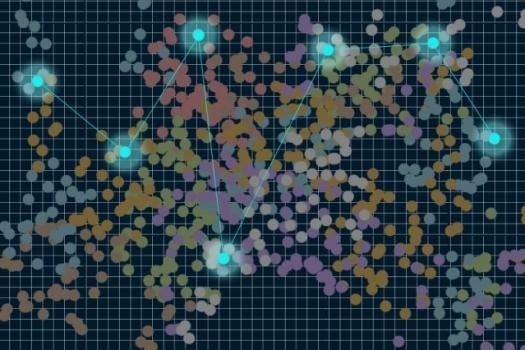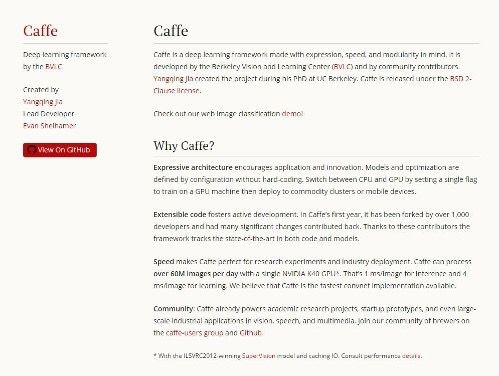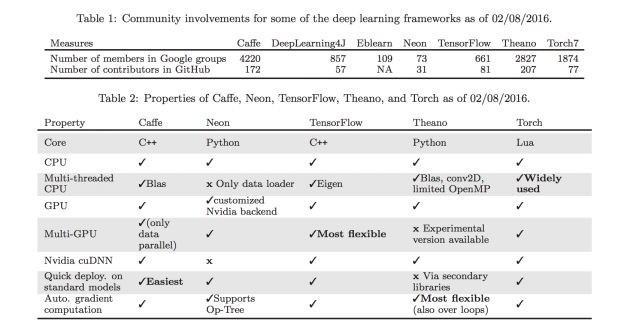Since the establishment of the Open AI has brought the open source of the AI ​​platform to its climax, Google, Facebook, Microsoft, Twitter and other companies have also embarked on the road to open source on their own platform to attract academic and industrial research. People, let them share more of their research results. Regardless of what these giants do (publicly sharing software and hardware design) to accelerate the overall development of the artificial intelligence industry, or to cope with compelling competitors, for those who are obsessed with AI, It is a good thing.
Just as you're in the vanguard of AI, these open source platforms can't help but jump into your eyes.
â–Ž hands to teach you Fun Google TensorFlow
Why did you choose Tensorflow as your preferred platform at first?
At the beginning, it was uncertain as to which learning platform to choose, and Tensorflow was not yet available at that time. The main considerations at that time were the maturity of the platform, the programming languages ​​supported, the support and efficiency of the GPU, the ease with which to use a neural network, the ease of getting started, the subsequent development of the platform, the development of the ecological environment, and the efficiency of the platform. . Although we have collected some rating materials, it is not easy to choose among the many factors, and it is not realistic to try one by one. Soon after, Tensorflow was open sourced from Google, and we chose it without hesitation.
First, TF has all the features we require (C++/Python language support, GPU, etc.). More importantly, we believe that the platform launched by Google will quickly accept and quickly form a corresponding development ecosystem and active follow-up development. Later facts also confirmed our expectations. The following table compares several popular platforms. The data comes from the arXiv paper published in February this year.
Click to read the full text.
MIT's latest programming language, Milk, accelerates parallel computing in the era of big data

This week, MIT released its new programming language, Milk, which can handle four times faster processing speed than existing languages ​​in big data.
This week at the International Conference on Parallel Architectures and Compilation Techniques, researchers from the Massachusetts Institute of Technology Computer Science and Artificial Intelligence Laboratory (CSAIL) released a new programming language— - Milk, which allows application developers to more efficiently manage memory in dealing with discrete data point problems in large data sets.
By testing several common algorithms, the program written in the new language, Milk, achieves four times faster than existing programming languages. But researchers believe that better results can be achieved through further research.
Saman Amarasinghe, professor of electrical engineering and computer science, said that the reason big data sets present problems for existing memory management technologies is not only because of their size, but also because they are sparse. In other words, the scale of the problem solution does not necessarily increase in proportion to the scale of the problem.
Click to read the full text.
â–Ž OpenAI teaches you how to build an infrastructure for deep learning research

OpenIC research engineers Vicki Cheung, Jonas Schneider, Ilya Sutskever, and Greg Brockman share in this article the infrastructure (software, hardware, configuration, and compilation) required to perform Deep Learning research and illustrate how to use the open source Kubernetes-ec2-autoscaler. Automatically extending the network model in deep learning studies will help a large number of deep learning and research enthusiasts to build their own in-depth learning infrastructure.
Deep learning is an empirical science. The infrastructure construction of a research team will have a major impact on future research work. Fortunately, today's open source ecosystem enables anyone to have the ability to build a more sophisticated deep learning infrastructure.
In this article, we will introduce how deep learning studies are usually conducted, describe our choice of infrastructure to support deep learning studies, and open source Kubernetes-ec2-autoscaler, a batch optimization extension for Kubernetes. Manager. We hope that this article will help you build your own deep learning infrastructure.
Click to read the full text.
â–ŽTwitter open source based on Lua/Torch enhanced learning framework torch-twrl

Torch has been around for a decade, but the real rise has benefited from last year's Facebook open source a lot of Torch's deep learning modules and extensions. Another special feature of Torch is the use of the less popular programming language Lua (which was used to develop video games). Today,
The goal of enhanced learning algorithms (agents) has always been to learn to perform complex, novel tasks through interactions with tasks (environments). In order to develop effective algorithms, rapid iteration and testing are crucial, and torch-twrl is open on schedule.
Drawing on other enhanced learning frameworks, torch-twrl aims to provide:
In Lua/Torch, an enhanced learning framework with minimal functional dependencies;
Define clear, modular code (to facilitate rapid development);
Seamless docking with Open AI's enhanced learning benchmark framework, Gym.
Click to read the original text.
â–Ž too above is not fun? The number of 15 open source artificial intelligence software, which one is your dish?
Artificial intelligence is one of the hottest research areas. Large companies such as IBM, Google, Microsoft, Facebook, and Amazon not only increased their capital investment in its development research department, but also started to acquire some small acquisitions in machine learning, neural networks, natural language and image processing. Start-up company. Given the current explosion in the field of artificial intelligence research, Stanford University professors recently made such a report: "The role of artificial intelligence software is getting stronger, and artificial intelligence software that has a strong influence on human society and economy will In the past 2030."
The foreign website Datamation has collated the currently popular 15 open source artificial intelligence softwares today. Lei Feng Network (search for “Lei Feng Net†public number concerns) (search “Lei Feng Net†public number attention) compiled the full text and introduced the following:
1.Caffe

......
......
......
Click to read the full text.
Switching Power Supply, CCTV Switching Power Supply, LED Power Supply,CCTV Camera Power Supply
Chinasky Electronics Co., Ltd. , https://www.chinaskyswitches.com
